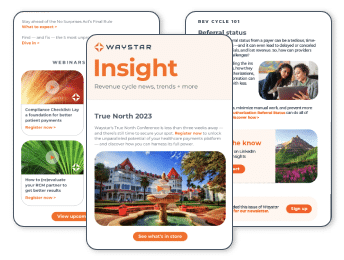The modern healthcare revenue cycle is more complex than ever, composed of numerous intricate steps and susceptible to factors often beyond a provider’s control. For many healthcare organizations, achieving any kind of success in the rev cycle is like trying to hit a constantly moving target.
A more demanding healthcare landscape
While revenue cycle management has always been demanding, COVID-19 has only exacerbated long-standing issues. The ongoing pandemic has been especially devastating for the financials of healthcare facilities across the U.S., with some reports estimating hospitals nationwide had lost $54B in net income losses in 2021 alone. In concurrence with financial losses, the majority of providers now find themselves struggling with staffing shortages. In fact, recent research has found staff turnover has increased to 30% for some departments. What’s more concerning is that an analysis of EMSI data predicts there will be a 3.2M deficit of healthcare workers by 2026.
With such heavy strain on providers, it’s imperative that healthcare organizations work to automate processes and effectively leverage resources in order to compensate. Thankfully, the technology and tools needed to do so are more widely available than ever. According to recent research completed by the Health Management Academy and Waystar, 22% of surveyed leading healthcare organizations reported they were currently using AI and RPA while 64% are actively considering it for the future.
General vs. purpose-built automation
As with all technology, there are key differences in the design and execution of such automated tools. Consider the striking differences between purpose-built automation and general purpose:
General-purpose automation
- Basic data movement
- High-volume, low-value tasks
- Define and maintain bots
Purpose-built automation
- Augmented intelligence
- Designed for specific use cases
- Built for high-volume, high-value tasks
The revenue cycle is simply too complex, and the data and information underlying each step so granular, that general-purpose automation is simply not well suited to handle the tasks necessary to keep things running smoothly in a healthcare setting. When you look at any number of back-end revenue cycle inefficiencies, claim attachments, claim statusing, appeals and posting and reconciliation of payments, you’ll find areas where the wrong tools and processes inevitably lead to lost time, wasted resources, and delayed reimbursement.
The advantages of a purpose-built approach
Purpose-built automation on the other hand, can be a boon to any area of the revenue cycle. Consider how managing claim statuses can be improved with:
- Curated data
- Automation can eliminate the manual work required for calling payers or logging onto payer websites for claim status updates
- Controlled claim follow-up and proactive remediation
- Intelligence normalizes payer responses and assigns them to custom work queues for simplified follow up
- Faster payment capture and more accurate AR forecasts
- Leveraging payer remittance data allows for more accurate payment forecasts on a per payer basis
Achieving success throughout the revenue cycle
As rev cycle teams navigate today’s challenging environment and demanding economy, it’s more important than ever to move beyond efficiency gains to incremental value. And leveraging a single platform for your revenue cycle needs is imperative to achieving that value. Consider the many benefits a truly unified revenue cycle management platform can offer:
- Performance benefits
- Consistent analytics and reporting
- Better eligibility and coverage detection
- Operational benefits
- Staff and workflow scalability
- Streamlined processes
- Strategic benefits
- Predictability and repeatability
- Simplified vendor and IT management
You’ll find a unified RCM platform can improve processes and procedures across the board. The proper tools can help eliminate revenue leakage, identify key areas for improvement, and reduce the time spent on denials, appeals, and managing claims statuses. And that’s just scratching the surface.
Wrapping it up: doing more with purpose-built automation
Modern healthcare providers can simply not afford to be caught in the past. Even before the pandemic, overreliance on outdated technology, and the need to depend on manual labor to complete the complex tasks involved made consistently achieving success in revenue cycle management seem like a pipe dream. But with the arrival of purpose-built automation, providers finally have the ability to achieve a truly simplified revenue cycle — one that lets them strive for that success, instead of struggling to keep up.
Looking to explore what purpose-built automation can do for your organization? Waystar’s platform simplifies healthcare payments across the revenue cycle. We empower healthcare organizations to automate manual work, gain insight into processes and performance, and ultimately collect more revenue.
Find this post helpful? Check out how front-end automation supports a more efficient + precise revenue cycle.


